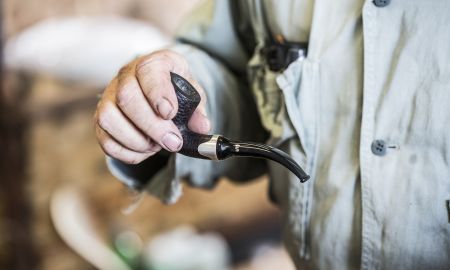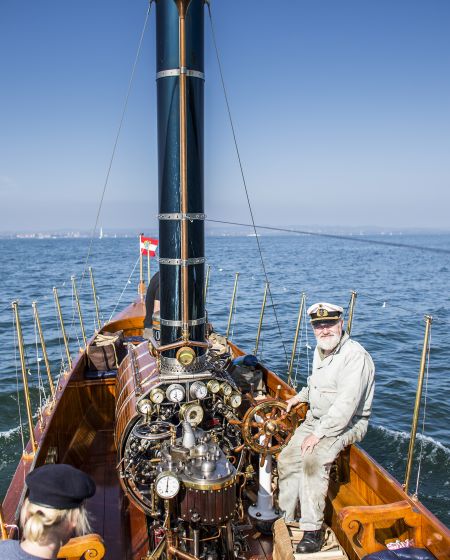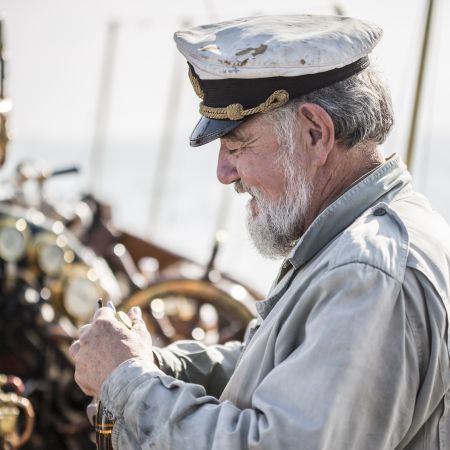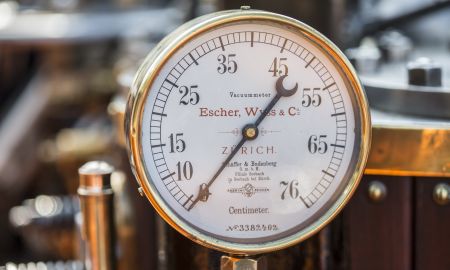The Duke of Argyll must have really loved his daughter – the elegant steam yacht bearing her name was a genuine prestigious object on Lake Windermere, the hotspot of the English nobility, in 1883. These days, Lake Constance is a hotspot for magnificent vintage boats, and all because three men with their headquarters in Liechtenstein and Hard couldn’t stop themselves from tackling and turning into reality completely impossible projects. And so the steamboat, which had been given up on, disfigured and ultimately cut a sadly bedraggled figure, was transformed into a beauty which, these days, is much more presentable than ever before.



The machine whisperer
Erich Hoop, Hubert Hartmann and Reinhard Kloser share a love of beautiful, exceptional, classically historic vehicles – those in the air, on water and on the road. Erich Hoop, one of the three, found the old steam yacht on the Internet, and the next day saw all three standing next to the River Thames, right in front of Windsor Castle, and taking their first test drive on the “Duchess of Argyll”. The boat was in urgent need of extensive renovation works. Her owner, a professor at Eton College, possessed neither the means nor the skills for such, and jumped for joy when the little steamboat immediately set off on its journey to Vorarlberg. Three days later, it arrived at Hartmann’s carpenters in Hard by HGV. There, it was taken apart plank by plank, and the numerous, arduous puzzle pieces were meticulously reassembled down to the very last detail. Repairing the rump of the ship and the interior design alone devoured countless working hours. Each and every plank, each and every part required its own pattern, with not one single part corresponding to the dimensions or the form of another.
Not to mention the lack of the steam boiler, the engine and all the loving decorations, most of which had to be reproduced after original photos. “That is the way I am,” says project manager Reinhard Kloser, “If I discover a boat like this, then I can imagine it in its completed state, the way it will be once it is finished. I can see every detail. And if I can visualise it, then I have to get cracking.” This explains a lot, but not how the trained ship engineer can repair an engine all of whose technical data and documents have been lost over time. “That’s precisely what I find so appealing about such a project,” he explains, amused. “If it were easy, anyone could do it. I love tricky, technical tasks.” If you can talk to engines and listen to them, you can find out from them how they work.
A successful interregional project
Even before the Duchess came along, Captain Kloser knew what it means to strip down into individual parts such a hopeless case, since without him the famous “Hohentwiel” paddle wheel steamer would still be rusting away on the shores of Lochau See. It is thanks to the fiddly tasks of its steam engine initiated by the engineer and experienced seaman that, today, it is a globally famous gem on Lake Constance. Reinhard Kloser has spent much of his life aboard large, some steam-operated, ships crossing oceans. Hubert Hartmann has also gained experience of his own with the individual parts of the Hohentwiel, and he didn’t join the new project in a state of ignorance. Despite this, he shakes his head in amusement when he talks about how much work was invested in the diagonal bracing of the rump alone, or in the 14 layers of varnish, or in the covering for the new boiler, etcetera. etcetera. etcetera. Such a task can only be achieved with the aid of numerous volunteers who participate just for the fun of it. The volunteers were in abundance during the work on the Hohentwiel throughout the entire Lake Constance region. A great deal of valuable knowledge from 186 companies involved came together, enabling something truly unique. The Hohentwiel is mobile proof of the international cooperation across all national borders, which ran smoothly and was characterised by complete dedication. The paddle steamer now calls at all of the shores of Lake Constance, connecting them, proving that it is enjoying a second lease of life. The repair of the Duchess shows this same bonding effect over and beyond the national borders and specialism. It is a happy experience for all those involved, for those putting their hearts and craftsmanship into one – or many – of the thousands of parts.



An odyssey around the world
Gone is the era in the 1920s when they used to fit a diesel engine on a ship. The odyssey of the main steam machine alone is evidence of which magic is involved if someone starts to awaken the love for an object: over time, the original machine has been removed, initially sold and used in England, then shipped to America where it was exhibited in a museum, where it was tracked down by fans of vintage vehicles and sent to Bodman on Lake Constance. There, the three new owners of the Duchess found the original part, started negotiations and brought it to Hard. Since then, the ship and its engine have been newly renovated, and supplemented with handicrafted individual parts, re-united as it were. It purrs like a sewing machine across the water, and that at a considerable speed – easily doing 11 knots an hour, which is the same as just over 20 km/h. When it comes to its vehicle dynamics and performance, the Duchess is one of the most interesting steamboats – there are five sea-worthy vessels of its type worldwide, with the Duchess being the oldest of them – and it is not inconceivable that one day it will set off for Lake Windermere in order to take part in one of the most exclusive steamboat races. It wouldn’t be the first time she picked up first prize there. For now, however, she is completing her first journeys on Lake Constance under the watchful eye of Captain Kloser and his crew: Hubert Hartmann, Reinhard Flatz and Erich Hoop, who are learning the tight manoeuvring of the boat at the narrow entry in the slipway and who have to get to grips with the peculiarities of the steam-driven boat.
For lovers of luxury…
Apropos shipyard: the Duchess was already a creature of luxury, delighting aristocratic society back then and at some point taking on a successful role as a film star (she played a supporting role during a chase by Sherlock Holmes in a BBC production). And, not quite three years ago, she captured the hearts of three men as soon as they clapped eyes on her. They (Erich Hoop and Hubert Hartmann) have even financed her very own, well, apartment. In this case it is a dry dock with lifting platform, designed totally in line with her measurements, which lets her glide gently into the water so that her rump isn’t constantly in the water. She is a lady after all, a lady with the power to enchant and bewitch, a lady that makes you forget all the hours of work put into her as soon as she silently paves her way through the water.
Reinhard Kloser
Soon after he had finished his apprenticeship as a machine fitter, Kloser signed on as a technical ship’s officer candidate at the traditional F. Laeisz shipping company in Hamburg. Following an intensive apprenticeship on long distance trade ships, and conclusion of his studies in marine engineering in Flensburg, he went to sea as second and third technical ship’s officer on modern refrigerator ships for a short time. As first technical ship’s officer (head engineer), he was responsible alternately for a steam ship and a steam turbine ship. Both ships came from the American stock from the Second World War, and belonged to the well-known “Liberty” and “Victory” class. He travelled through the Suez Canal six times and the Panama Canal 52 times during his 12 years at sea.






